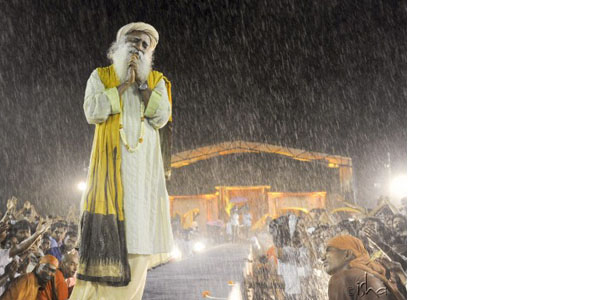Water Scarcity Is The Real Problem, Not Water Pollution

“There is only one source of water, which is monsoon rain. Rivers, ponds, lakes and wells are all destinations for the water, not the source.”
—Sadhguru
Sadhguru : One big problem in India is that everybody thinks they are environmentalists just because they read a newspaper article or they saw something on the television for two minutes. Right now, we are obsessed about pollution because America and Europe talk about pollution. We have this ailment that whatever is said in Europe or America, Indians want to repeat. This has become fashionable. This is a huge problem with the English speaking people in this country. Whether it is a journalist or even a so-called environmental scientist, it is so difficult to get even one simple point across, because Europe and America are dancing in their heads all the time.
Fundamentally, we have a misunderstanding that a river is a source of water. No. A river, pond or lake in this country is not a source of water. There is only one source of water, which is monsoon rain. Rivers, ponds, lakes and wells are all destinations for the water, not the source.
Pollution is not the real problem. We must understand that if sewage water stops going into the rivers, most rivers will not flow. Take Yamuna for example. Ninety percent of the water there is sewage water. If you stop all the sewage water, there will be no Yamuna.
The realities of a tropical nation are very different from a nation which has temperate climate. For the latitude in which we are and the kind of land we have, it is very different. Fundamentally, we have a misunderstanding that a river is a source of water. No. A river, pond or lake in this country is not a source of water. There is only one source of water, which is monsoon rain. Rivers, ponds, lakes and wells are all destinations for the water, not the source.
The monsoon rains every year shed around 3.6 to 4 trillion tons of water, approximately, on this land. When this was a lush rain-forest or a tropical forest, we held a large part of it in the land as groundwater and let it out slowly, so rivers flowed. In the last hundred years, there has been no significant dip in the volume of water that the monsoons are shedding on the subcontinent. But all the rivers on an average have depleted over forty percent. Krishna has depleted over sixty percent. Narmada has depleted over fifty-five percent. Ganga has depleted over forty percent.
We need to understand that the European rivers are largely glacier-fed, while Indian rivers are forest-fed. Only four percent of India's river water is glacier-fed, and that is only up in the north. Of these glacier-fed rivers, most flow into Pakistan. Only a little bit of water in the Ganga is glacier-fed, the rest of the rivers are all forest-fed.
Ganga basin accounts for twenty-six percent of India's geography and almost a third of India's agriculture. To build the Indian railways, we ripped off vegetation in that whole region. In seventy years’ time we have taken down seventy-eight percent of tree cover in the Ganga basin, and you expect that river to flow? You are still talking about pollution? If we make up our minds, we can fully fix the pollution in two to three years’ time. It is not a big deal. If we are determined and invest the money, we can make sure that the water is clean. But when a river depletes, it will take decades of action to bring it back. It cannot be revived so easily. The river will not start flowing tomorrow just because we decide to do something fanciful today.
But whichever way you try to talk about it, everybody wants to talk about pollution, because city people are suffering from pollution and all the investment, power and the power of the gab is also in the hands of the city people. Well, now, they have started talking about water shortage because there is no drinking water in the cities. According to the Composite Water Management Index (CWMI) report released by the NITI Aayog recently, many major cities including Delhi, Bengaluru, Chennai, Hyderabad may have no groundwater by 2020, affecting nearly a hundred million people.
No population on the planet is as water-distressed as the Indian population. It has seventeen percent of the world's population but only about 3.5 percent of the world's water resources. At any time, no population should use more than fifteen to twenty-five percent of its groundwater resources. But today, over eighty percent of the water we consume and use is groundwater resources.
In spite of that, most cities are in fear of rain and they're singing that old song -“Rain, rain go away,” because they know floods will follow. They don't know how to manage a flood in the city, because cities are not designed to handle floods. If it rained and if there was enough vegetation, there would be no flooding. If we plant 10,000 trees, nearly thirty-six million liters of water sequestering will happen. So, now, in the Cauvery basin, we are looking at planting 2.42 billion trees as part of Cauvery Calling. Ultimately, a variety of vegetation is necessary for the rivers to flow. Before we fall dead, we must make this happen.


